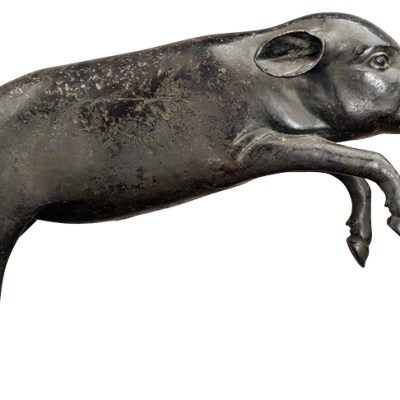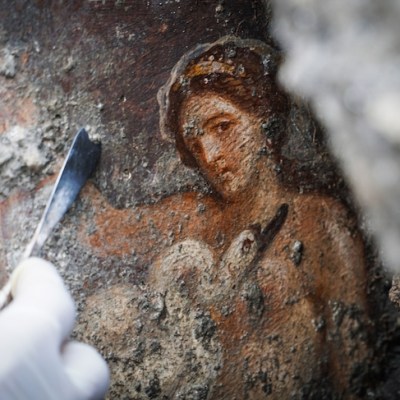From the September 2024 issue of Apollo. Preview and subscribe here.
The view directly ahead of me is classically, achingly picturesque: Vesuvius as backdrop, its distinctive outline purple-blue against an azure sky, while in the foreground umbrella pines soften the scene’s edges above a group of ancient columns and sections of stone wall. Spread out below my feet, meanwhile – I am standing at the edge of a drop – is what looks like a building site: a thicket of scaffolding topped with corrugated metal sheets, buckets, hoses, and men in hi-vis hard hats and tabards. In the shadow of a makeshift wooden shelter a woman dressed in white appears to be laying a wall. What she’s actually doing, of course, is conservation work on the latest architectural element to emerge from the most recent excavation at Pompeii. To my right, huge mounds of what could be construction gravel are in fact lapilli, or pebbles of pumice, that have been removed from the site as the dig has progressed. This material was spewed over the city for some 19 hours in AD 79 (the exact date is disputed). It was the first phase of an eruption that Pliny the Younger, watching from a distance at Misenum, described as resembling the shape of one of those umbrella pines. The next phase, a rush of super-heated toxic gas and scorching ash known as a pyroclastic surge, instantly killed and buried anyone left alive.
This is Insula (block) 10 of Regio IX, and since digging started here early last year it has yielded finds to delight specialists and spectators alike: walls of cinnabar red, Egyptian blue and charcoal black painted with mythological figures, animals and slender columns; gladiatorial graffiti, stucco serpents and all the paraphernalia of daily Roman life, including the remains of a fish stew. Most sensational was the discovery of a fresco seemingly depicting a pizza, which generated a huge amount of interest and had the likes of Neapolitan pizzaiolo Gino Sorbillo and the Rome-based food writer Rachel Roddy attempting to recreate it.
A painting depicting a piece of focaccia with various fruits, and spices and nuts on the side illustrates the gifts of hospitality offered to guests in the atrium of a newly discovered house. Photo: courtesy Parco Archeologico di Pompei
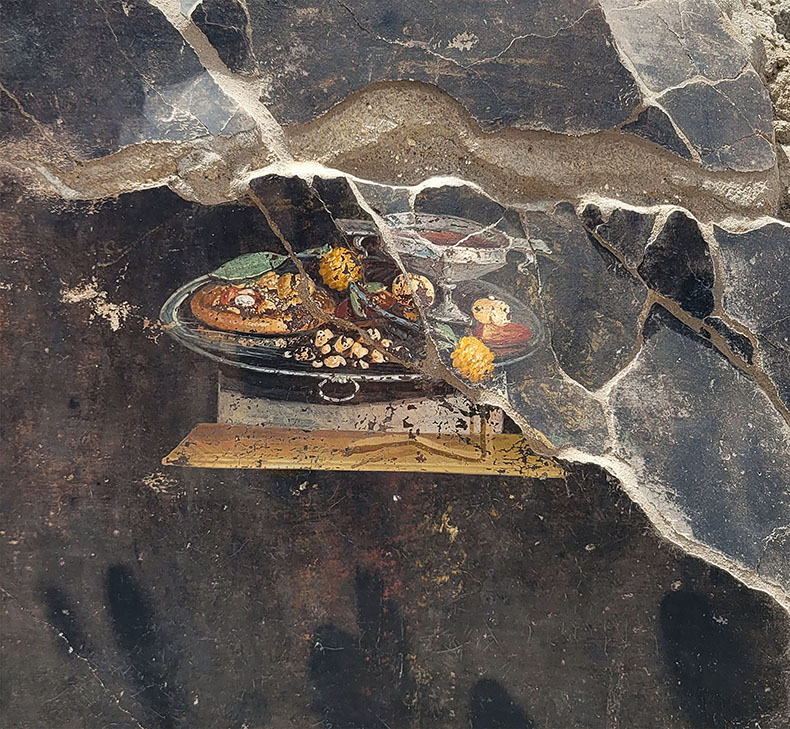
‘Things went absolutely nuts after we released that story,’ confirms the archaeologist Sophie Hay, who has worked on and off at Pompeii for nearly 30 years. In that time, she says, she has seen things improve ‘considerably’. To get to Insula 10 of Regio IX, which lies towards the northern fringe of the excavated city, we have come through the Porta di Stabia, the old Roman gate at the south end, turning right into Via dell’Abbondanza, the main street running from the Porta Marina in the west to the amphitheatre in the east. We soon turned off north again uphill, but if we’d continued further along Via dell’Abbondanza we would have come to the Schola Armaturarum, a military building unearthed in 1915. Having been restored in the 1940s after Allied bombers mistook Pompeii’s corrugated-metal protective roofs for enemy dugouts, in 2010 the structure collapsed, taking precious frescos with it. The pile of rubble became emblematic of years of neglect, mismanagement and local corruption, and prompted an intervention by the EU, which handed the site management €105m. So the Great Pompeii Project was born in 2012 and turbo-charged under Massimo Osanna, director from 2014–21. As well as general maintenance, conservation and better security, one of the project’s main objectives was to shore up and rationalise boundaries between areas that have been excavated and those that have not. One of the contributing factors in the collapse of the Schola Armaturarum is thought to have been the pressure exerted on the building by the badly drained, steep scarp slope of the unexcavated land immediately behind it.
As we stand on the high, unexplored ground that forms most of Regio IX, Hay points over to the northern end of Insula 10, which until last year lay almost completely covered over, between two exhumed blocks. ‘The only bits that had been touched were the facades, where they meet the Via di Nola – in the late 19th century they had started digging all of that street and had poked around in a few of the front rooms, but they left it unfinished.’ Essentially, that left a protruding ‘tongue’ of unexcavated land that was a risk to the excavated buildings around it. ‘So by digging this block and lopping off the tongue,’ Hay explains, ‘you create a straight edge, and it’s easier to maintain one edge than three.’ Fronti di scavo (excavation fronts) are getting similar treatment in other areas, too. In other words, the largest dig in a generation at Pompeii has arisen not from an appetite for new discoveries, but for practical considerations. ‘Of course,’ Hay says, ‘as a big bonus we get to do some excavation too. But for everything we excavate we need to preserve, conserve and maintain.’ Overall there are more than 1,500 structures – some 13,000 rooms – in the 44 hectares of the town that have been unearthed.
Later, in the welcome cool of his air-conditioned office, I raise this issue with Pompeii’s current director, Gabriel Zuchtriegel, who, having come from Paestum, brought with him a wealth of experience in running an archaeological site (as well as a Harris’s hawk, to discourage fresco-damaging pigeons). ‘This latest uncovering was an experiment which we inherited from the previous leadership, but our experience has shown that it was somehow a miscalculation: what you gain in terms of improvement – the fact that you have a much shorter fronte di scavo, or border – you lose four or five times over in terms of the enormous costs involved, millions [of euros] to excavate and then millions and millions to restore, to make accessible.’ He indicates on a map where this excavation will now come to a halt. ‘For me it’s like public debt. Because what you’re actually doing is loading on future generations the weight of what you’re doing now.’
Beyond the question of resources, there is also consensus that what remains – one third of the ancient city still lies buried – should be left for ever-more sophisticated future technologies. ‘I think we have a serious responsibility to do that,’ says Hay, who reveals she is researching a book on the women involved in excavating Pompeii. ‘One of them is Caroline Bonaparte, Napoleon’s sister. Her plan [as Queen of Naples] was that the whole of Pompeii would be excavated in three years. And thank god that didn’t happen, because it would have been an untold disaster.’ Visible in some of the walls in Insula 10 are gaping holes, evidence of the rough tunnelling practised under the Bourbons who plundered the buried city, after its rediscovery in 1748, for statues, bronzes and other Roman treasures to adorn their palaces.
When we descend into the site – a complex comprised of residential house, bakery and laundry at the front, with a much grander domus emerging directly behind it – Hay points out an immaculate set of roof tiles, neatly stacked next to a large pile of tuff bricks. In another area are mounds of stone rubble and lime. This is a building site after all – it just happens to be nearly 2,000 years old; the whole block was evidently undergoing restoration work when the fatal eruption hit. Among the evidence of life found here were tools, remnants of the workers’ lunch, and on the plaster of an unfinished staircase someone (the builders themselves?) had drawn charcoal sketches of gladiators in combat – as well as a stylised penis. It all feels fairly familiar.
The walls of a shrine room are painted in Egyptian blue and the niches for sacred objects are cinnabar red. Piles of oyster shells (to be added to plaster) and rubble are evidence of building work in progress when Vesuvius erupted. Photo: courtesy Parco Archeologico di Pompei

Leaping gazelle on the black border that around the lower part of the walls of the shrine room. Photo: courtesy Parco Archeologico di Pompei
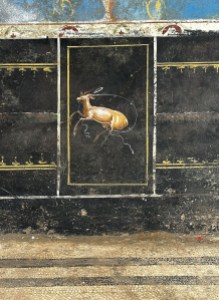
Nearby, a sacrarium, or shrine room, was unearthed to reveal walls painted in an expensive pigment of Egyptian blue, with cinnabar-red niches for sacred objects or images. Slender columns, canopies and pediments, painted in gold, provide an architectural framework for figures representing the four seasons and agriculture – a city-dweller’s romanticising of rural life, perhaps. A black border running along the lower register of the space is decorated with a leaping gazelle. It’s a jewel-box of a room, yet my guide is again urging me to focus on heaps of rubble on the floor. ‘These are really interesting,’ Hay enthuses, ‘because they show us the economy of construction, how builders work and what materials they brought in in bulk, and in what state.’ Certainly the neat little piles – which look like they were deposited here only yesterday – make you marvel at the care with which the excavators have teased away the layers of pumice pebbles. ‘We’ve had building materials come to light elsewhere in Pompeii,’ Hay explains, ‘but the amount and the variety we’ve got here is unusual, because we’ve kept it rather than sweep it up, which early excavations might have done.’
One of the heaps is a pile of oyster shells, which could be ground down to make a calcium-carbonate-rich powder, then added to plaster to lend it a sheen. The encyclopaedist (and victim of Vesuvius) Pliny the Elder tells us that oyster farms had existed in the Gulf of Naples since the 2nd century BC to cater to the tastes of wealthy diners. It’s tempting to imagine the owners of this house saving up the shells after their banquets, but it seems more likely that those found here were supplied by the construction trade.
If oysters were eaten in this house, it would have been in a black-painted triclinium across the courtyard – a breathtakingly beautiful room, despite the relative restraint of its decoration. Perhaps whoever commissioned it was following the advice of the Augustan architect Vitruvius, who in his treatise De Architectura suggested that neither paintings of great detail nor delicate cornice work were appropriate in winter dining rooms, because smoke from the fire and ‘the constant soot from the lamps’ would spoil them; panels of black, he commanded, should be ‘worked up’ on the walls. In fact, the diminutive central scenes on the dark walls have been painted in exquisite detail: on one side, the Trojan prince Paris meets Helen, wife of the Spartan king Menelaus. Most charming is Paris’s dog – thought to be a Molossian hound, an ancient breed – who looks out at us with a distinctly worried expression, as if he knows what’s to come of this disastrous union. On the opposite wall is a related vignette featuring Apollo, leaning nonchalantly against his lyre, and the Trojan princess Cassandra.
In Aeschylus’s tragedy Agamemnon, the enamoured god gave Cassandra prophetic powers in exchange for sex, but when she broke her side of the bargain Apollo willed it that her prophecies should never be believed. Here she is wreathed in laurels – the god’s symbol – sitting on something that looks like a beehive, but is in fact, Hay tells me, the Delphic omphalos, a stone representing the ‘navel of the world’. She has her right hand to her forehead in a gesture of anguish; like the dog, she knows what’s coming for her city, and for her. It’s difficult, of course, to look at such scenes of impending doom and not think of the fate of Pompeii.
The god Apollo poses with his lyre in front of the doomed Trojan princess Cassandra – another scene from the newly discovered dining room in Insula 10 of Regio IX. Photo: courtesy Parco Archeologico di Pompei
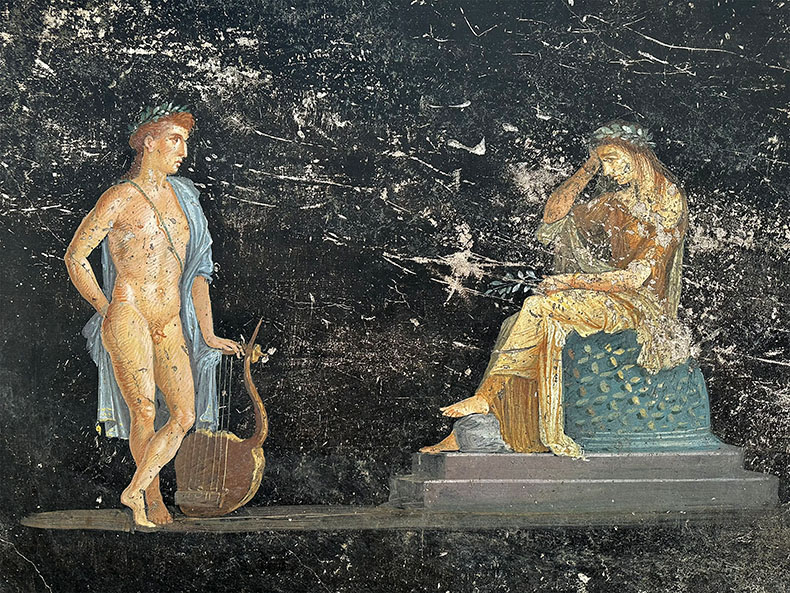
Illusion and allusion reign in Roman frescos, and mythological subjects, including the Trojan War, appear frequently. Some of the best-known examples in Pompeii were found in the so-called House of the Tragic Poet (which, excavated in 1824–25, provided the main setting for Edward Bulwer-Lytton’s 1834 novel The Last Days of Pompeii; many of the wall paintings, like so much from Pompeii and Herculaneum, are held in the Museo Archeologico Nazionale in Naples). Then as now, interior decoration could reflect aspiration as much as status. Tellingly perhaps, the House of the Tragic Poet has at its entrance the famous mosaic depicting a fierce-looking dog straining at its chain over the words ‘CAVE CANEM’ (‘Beware of the dog’). In his Neronian satire the Satyricon, probably written only a decade or two before the eruption, the writer Petronius puts the same device in the house of Trimalchio, a nouveau-riche former slave whose walls are covered with scenes from the Iliad and the Odyssey. For a taste of Roman snobbery, look no further than the reaction of Trimalchio’s dinner guests to such pretensions from a man whose acquaintance with the Homeric epics turns out to be passing at best.
What to make, then, in this newly uncovered dining room, of the fact that between the figures of Helen and Paris someone has scratched their names in Greek? Was the scene too subtle for many visitors? Did the owners tire of being asked by dinner guests who the figures were, and after an evening fuelled by Campanian wine, label them? (If this were a Petronian satire, the aide-memoire would have been for the owners themselves.)
The female figures on either side of the niches in the shrine room include allegories of farming and the seasons. Photo: courtesy Parco Archeologico di Pompei
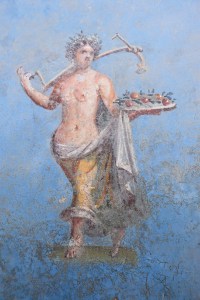
In a temporary storeroom a short distance from the dig, archaeologist Ausilia Trapani shows me a large worktable spread with painted fragments from an upper-floor ceiling of the house that collapsed under the weight of the accumulated lapilli. Like the Trojan scenes on the triclinium walls, the quality of the painting is high, the pigments expensive. Images related to the Dionysian cult – maenads, tragic masks, a panther, garlands bursting with pomegranates and figs – are in various states of assembly. Trapani and her colleagues have been trying to piece together as much as they can, but it’s a Herculean task that would defeat the most practised of jigsaw puzzlers. A project named ‘RePAIR’, which launched in 2021 and is currently training AI and robotics to do this job, might make things easier in the not-too-distant future. Lining the room from floor to ceiling are crates and boxes full of artefacts found in the dig. One shelf holds the plaster cast of a door – or half of one, to be precise. ‘While one side of the door was in the pumice,’ Trapani explains, ‘this side had been buried in the ash layer, so we could take a cast from the impression it left.’
Pouring plaster into the cavities left in the solidified ash by decomposed organic material – most famously, of course, human bodies – has been a characteristic feature at Pompeii since the Neapolitan archaeologist Giuseppe Fiorelli started the practice in 1863. Casts showing victims at the very moment of death hold more fascination for some visitors than anything else they might see at Pompeii. At one point during my guided tour, a young man interrupts Hay to ask where the dead people are. ‘I think 95 per cent of visitors come here to see bodies,’ she tells me, having directed the cadaver-spotter to the newly reopened Villa Imperiale, where some casts – including the famous dog – are displayed in glass cases.
Fiorelli was director of excavations here from 1860–75; it was he who divided the town into regiones, insulae and house numbers. He also commissioned the German-born photographer Giorgio Sommer to capture his casts of Pompeiian victims – a double capturing, if you like – as well as important buildings including the House of the Vettii. Images such as these not only are invaluable records of a particular point in Pompeii’s history, but have also shaped the way we experience the place, whether in person or at a distance. Following that tradition, the Parco Archeologico di Pompei recently commissioned a sumptuous volume of photographs by Luigi Spina – an atmospheric tour of the city’s finest houses but also a record of much of the Grand Project’s work. Long inaccessible to visitors, many of the domus featured in the book are now reopening, the House of the Vettii among them.
The House of the Vettii, which has reopened as part of the Grand Pompeii Project, belonged to two wealthy traders and contains paintings by the most fashionable artists of their day. Photo: © Luigi Spina

Zuchtriegel has looked back to Fiorelli’s example for more scholarly publications, too. Taking inspiration from the latter’s Giornale degli scavi di Pompei, since last year he and his team have published an e-journal with regular reports and updates on the most recent findings from the site. Encouraging people to move beyond the physical boundaries of Pompeii itself is another focus for this director. Excessive visitor numbers to the ancient city are problematic both for conservation conditions and for the visitor experience. On a certain ticket tourists can now take a shuttle bus to the undeservedly overlooked Vesuvian sites of Boscoreale, Oplontis, Civita Giuliana and Stabiae (Herculaneum has been under separate management since 2017). These sites are where, Zuchtriegel believes, investing in new excavations makes financial sense.
‘Pompeii like any other town,’ Herman Melville wrote in his diary after visiting in 1857. ‘Same old humanity.’ Part of the site’s great appeal is that on one level visitors can read it – walk it – in a way that doesn’t need specialist explanation; it is immediately recognisable to us as a city, with streets, water fountains, bars, fast-food joints, toilets and graffiti. We are thrilled by perceived similarities – pizza! – which perhaps makes it all the more uncomfortable when the mirror Pompeii holds up to us is blackened. When, for instance, a few rooms away from that gorgeously painted triclinium is a confined space where enslaved workers and blindfolded donkeys milled grain, with the only source of daylight some small iron-barred windows near the ceiling. Or when one plaster cast of a woman revealed she was manacled, presumably unable to attempt escape. One wall in the excavation at Insula 10, Regio IX offers up a neat visual metaphor for this extraordinary place: a panel of ‘Pompeiian red’ with a wave of yellow ochre creeping up from the bottom, like a litmus test. Many of the city’s signature red walls, it turns out, were originally yellow, until the heat of the eruption changed their colour. You think you know us, the wall seems to say – think again.
From the September 2024 issue of Apollo. Preview and subscribe here.
